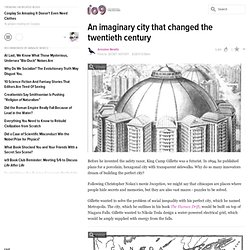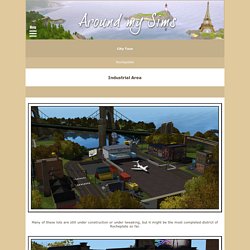

Futurology: The tricky art of knowing what will happen next. 23 December 2010Last updated at 02:38 By Finlo Rohrer BBC News Magazine Cheap air travel was among the predictions (illustration from Geoffrey Hoyle's book) A 1972 book which predicts what life would be like in 2010 has been reprinted after attracting a cult following, but how hard is it to tell the future?

Geoffrey Hoyle is often asked why he predicted everybody would be wearing jumpsuits by 2010. He envisioned a world where everybody worked a three-day week and had their electric cars delivered in tubes of liquid. These colourful ideas from his 1972 children's book, 2010: Living in the Future, helped prompt a Facebook campaign to track him down. Крутая мебель. FANDOM powered by Wikia. "Industrial Junk" Junktown is one of the smaller towns in southern California.

It was founded shortly after the War by a soldier named Darkwater.[1] Instead of building on the ruins of an old town, he thought it would be better to begin from the ground up. As the name suggests, it was built after the Great War out of random pieces of junk, mostly from wrecked cars. The town mostly lives off of trading and has a reputation for open hospitality. Background Edit. AirDrop House: Sustainable housing solution for flood-hit areas. Conceived by architect Andrew Maynard and his team, the AirDrop House is a sustainable housing solution for flood-hit areas.

The tiny houses made from dried sponge-like material could be dropped onto the affected areas by standard military aircrafts. 11 fascinating funeral traditions from around the globe. During Kelli Swazey’s talk at TEDMED, she showed a slide of a Torajan family posing with their deceased relative.

The funerals I’ve attended have all been very much the same. A closer look at communities thriving in unexpected places. In Caracas, the capital of Venezuela, nearly 70 percent of the population lives in slums that appear to drape like silk over every hill of the city. Iwan Baan: Ingenious homes in unexpected placesIwan Baan is not as interested in what architects build as he is in the beautiful ways that people appropriate the spaces once the planners are gone.
In today’s talk, Baan — whose breathtaking image of lower Manhattan after Hurricane Sandy hangs on at least one of our walls — shows incredible images from communities thriving in ways that seem quite opposite to the uniformity of suburbs. First, Baan takes us to Chandigarh, India, where people inhabit buildings created by modernist architects Le Corbusier in very different ways than expected. Then, Baan takes us to Caracas, Venezuela, where an abandoned 45-story building has become a miniature city. Baan’s talk will have you marveling at human ingenuity. With no lifts or escalators, the tower is essentially a forty-five-story walk up. An imaginary city that changed the twentieth century. Yes, it does.

It's very weird that a captain of industry like Gillette would come up with such socialist-sounding ideals. You'll note he was a member of this little socialist nutjob group before he caught a clue and successfully marketed the safety razor. Interestingly enough he didn't do very well until he hit upon saving time as a method of selling his safety razors. People didn't care how save they were but they did care about the time they'd save honing their straight razor. A green roof! Sustainable Green Buildings - Earthship Biotecture. Caves of Wonder. A series of massive caves was recently discovered in Vietnam.

The passage into the caves is about 300 feet wide and nearly 800 feet tall. And that's just the lobby. Inside the depths of the largest of the caves sits a real live jungle! This is potentially the largest cave in the world, and it was only recently discovered. Futuristic Vertical City Holds Plug-In Hexagonal Housing Units. Share on Tumblr Email Malaysian architect Tay Yee Wei recently unveiled a towering vertical city populated with hexagonal housing units that offer a solution to urban population growth problems in Asian cities. The tower itself serves as a scaffolding — as the population of urban areas fluctuates, modular units can be “plugged in” to the structure to accommodate an expanding population.
Venue design. Around my Sims. Around my Sims. Another characteristic of my towns (yes, it was the same with Sandy Valley) is that I build stuff mostly without knowing the use I'll make of them, except for schools or city halls, or other typical buildings.

But right now, I don't know what kind of shops or restaurants I'll make, nor in which building they'll be. I'll simply adapt my projects to the lot I have built, when I have an idea for it. It's my way to give a more organic (and also maybe more european) look to the town. Then, I'm adding details, like flowers, balconies, urban objects... I'm very far to be done with these, as I actually need to mesh some stuff for this new town, also I haven't chosen yet the street lights. Around my Sims. Around my Sims. Many of these lots are still under construction or under tweaking, but it might be the most completed district of Rocheplate so far.

La Glisse, the skate-board and surfing-board store, run by Aaron Delport La Friperie, second-hand clothing store, run by Noémie Lafleur The Skateboard park, where an unformal bar should open in a container Some residential buildings. Around my Sims.